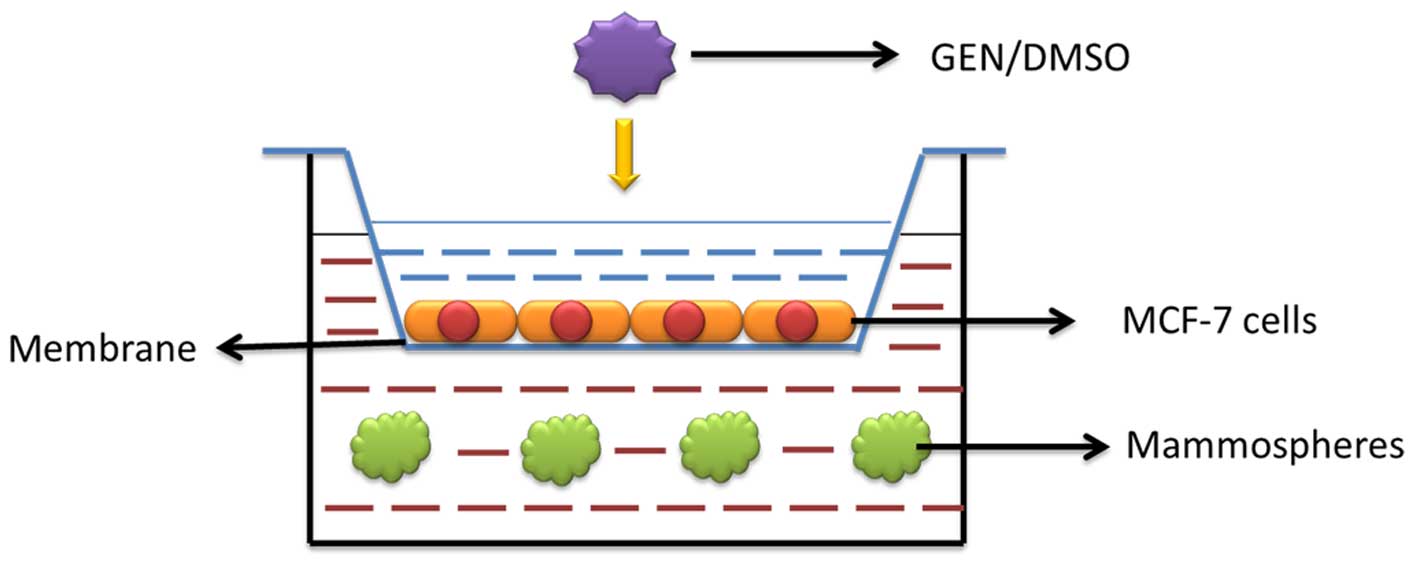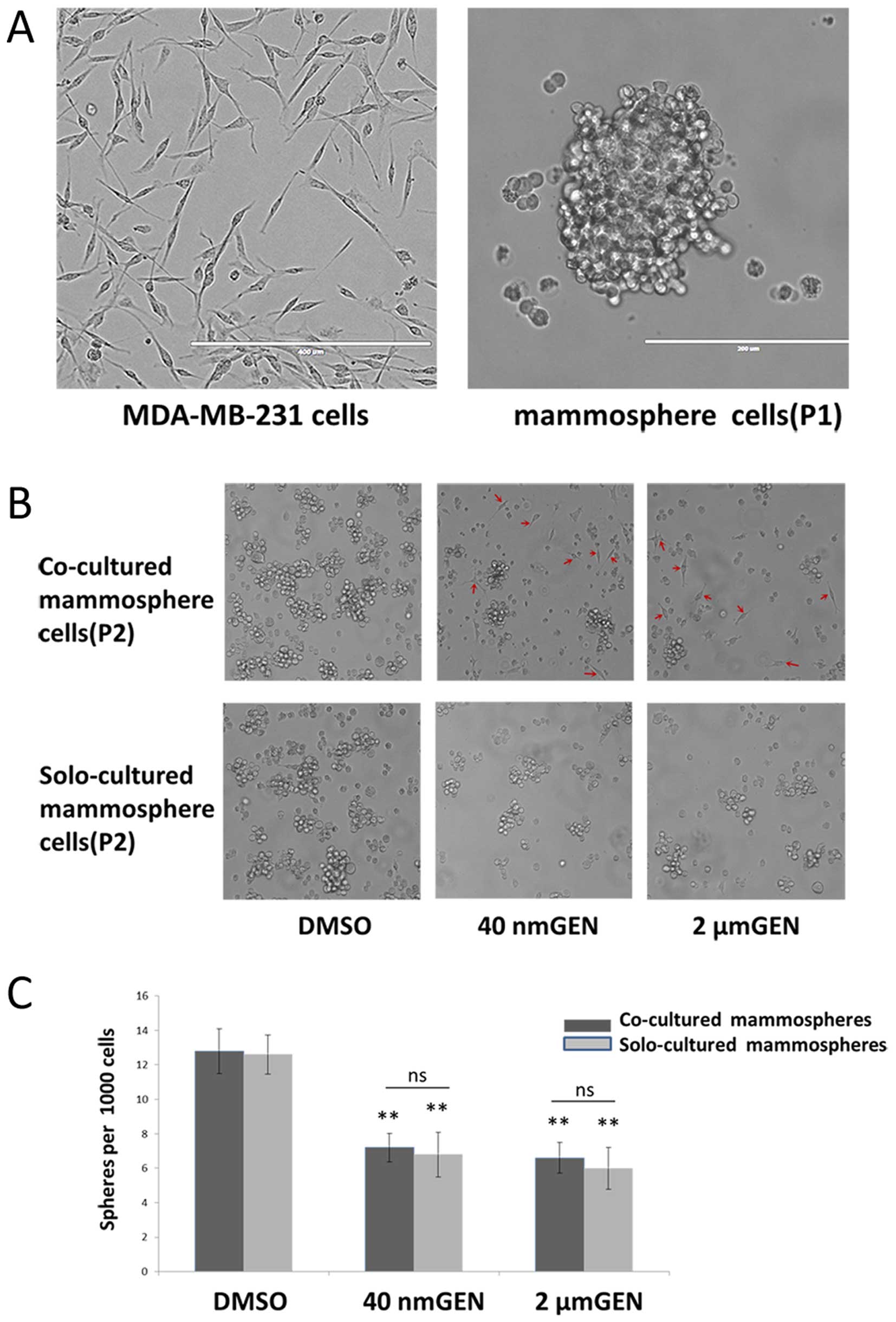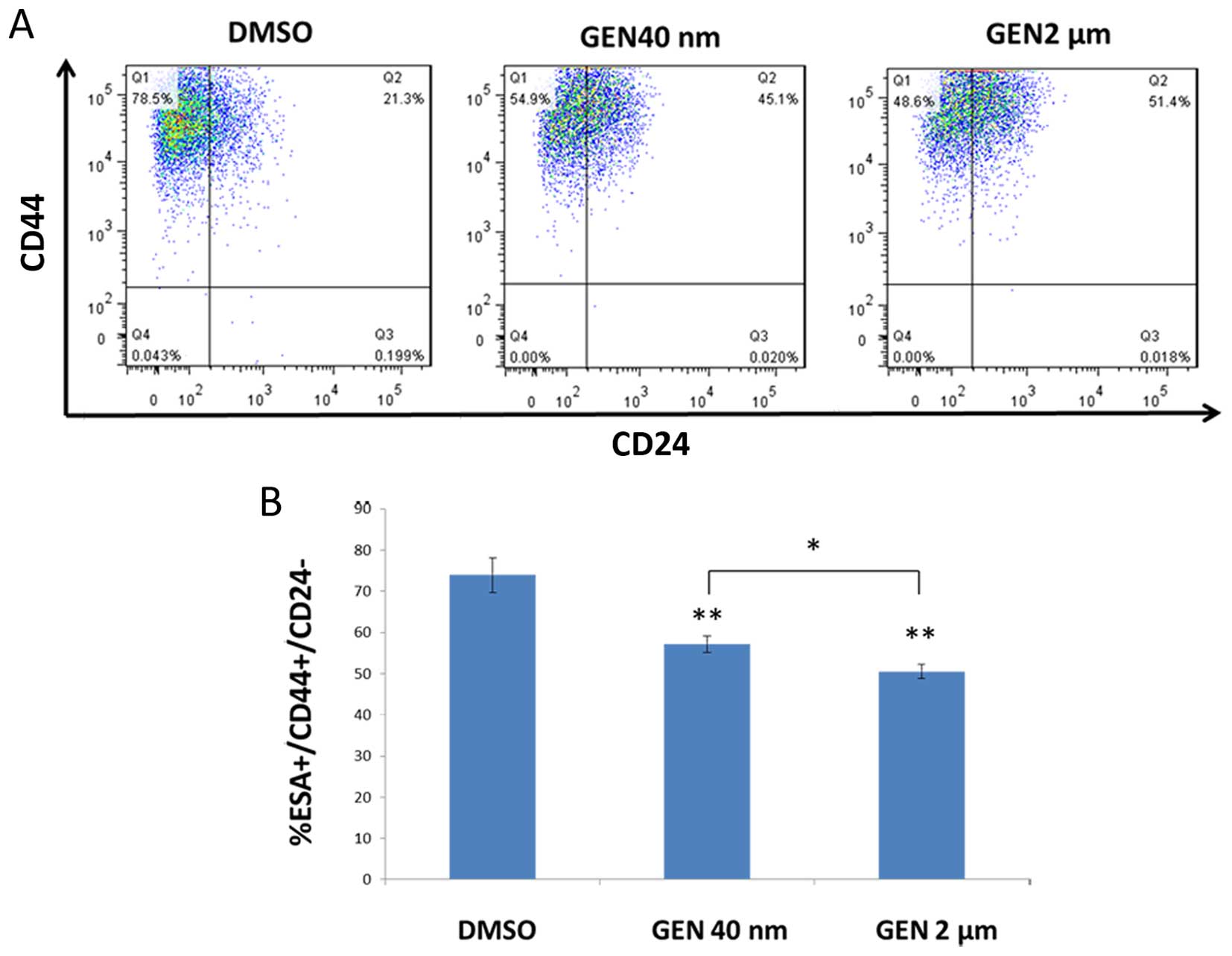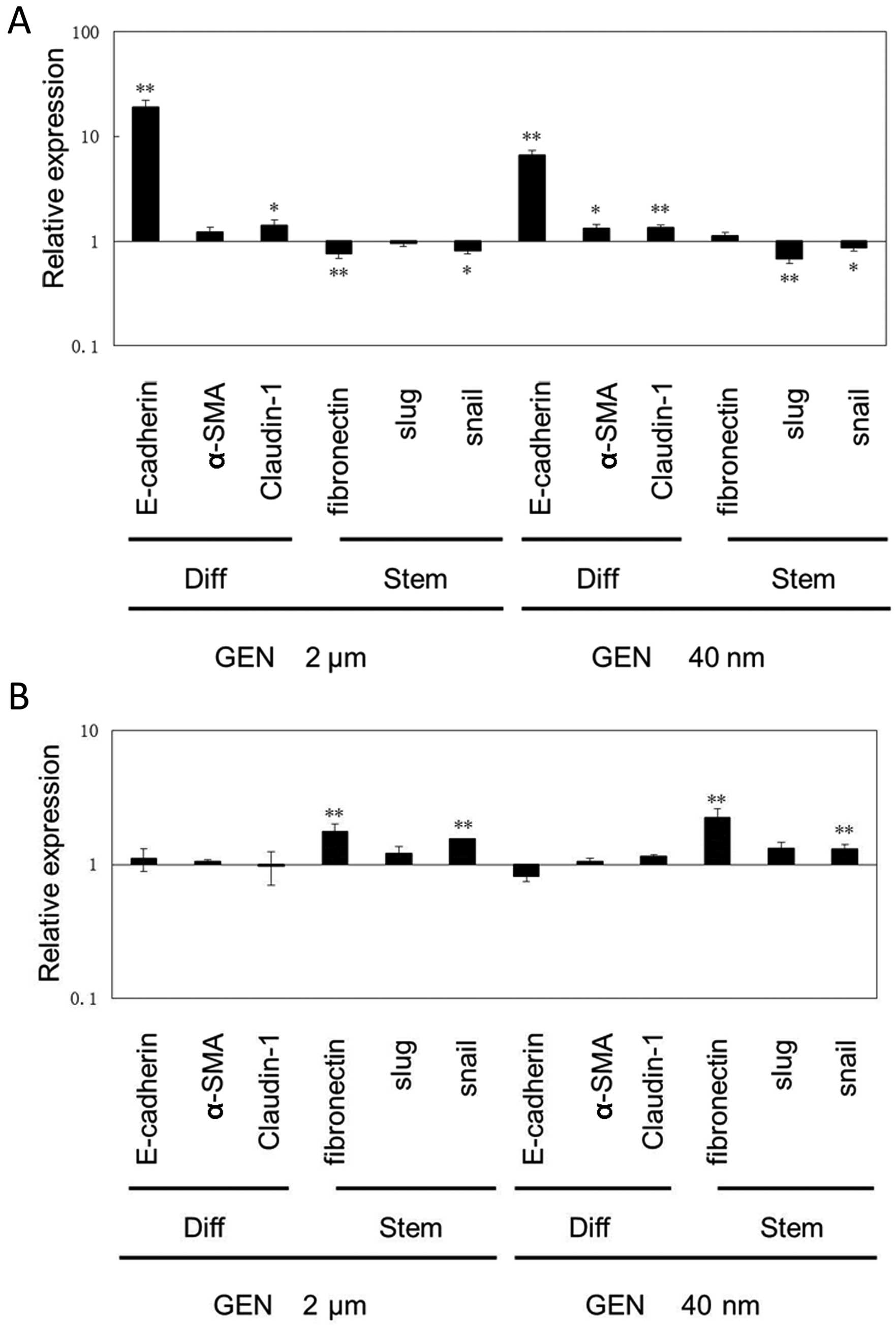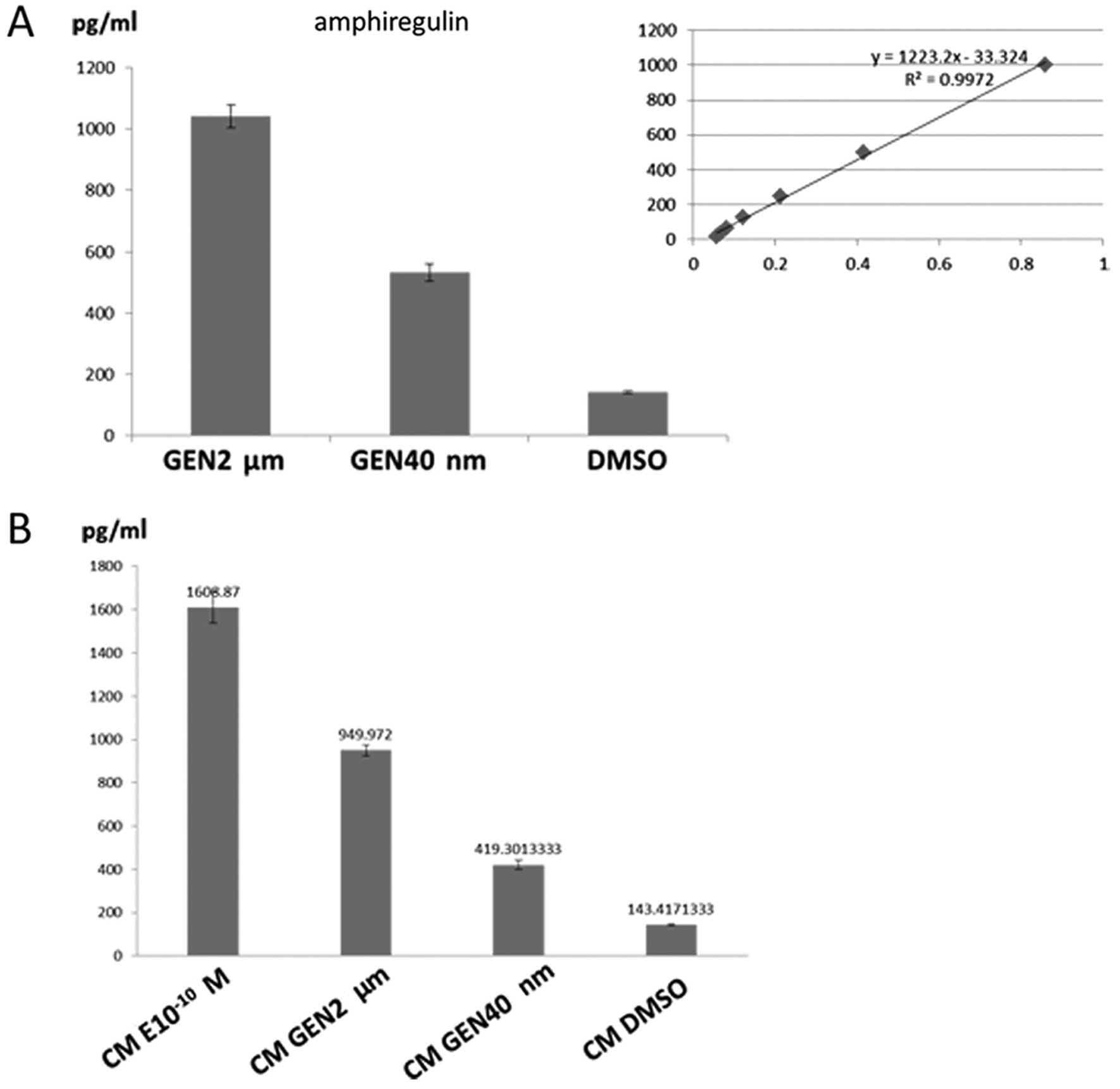|
1
|
Wu C and Alman BA: Side population cells
in human cancers. Cancer Lett. 268:1–9. 2008. View Article : Google Scholar : PubMed/NCBI
|
|
2
|
Dave B and Chang J: Treatment resistance
in stem cells and breast cancer. J Mammary Gland Biol Neoplasia.
14:79–82. 2009. View Article : Google Scholar : PubMed/NCBI
|
|
3
|
Visvader JE and Lindeman GJ: Cancer stem
cells in solid tumours: Accumulating evidence and unresolved
questions. Nat Rev Cancer. 8:755–768. 2008. View Article : Google Scholar : PubMed/NCBI
|
|
4
|
Li X, Lewis MT, Huang J, Gutierrez C,
Osborne CK, Wu MF, Hilsenbeck SG, Pavlick A, Zhang X, Chamness GC,
et al: Intrinsic resistance of tumorigenic breast cancer cells to
chemotherapy. J Natl Cancer Inst. 100:672–679. 2008. View Article : Google Scholar : PubMed/NCBI
|
|
5
|
Creighton CJ, Li X, Landis M, Dixon JM,
Neumeister VM, Sjolund A, Rimm DL, Wong H, Rodriguez A,
Herschkowitz JI, et al: Residual breast cancers after conventional
therapy display mesenchymal as well as tumor-initiating features.
Proc Natl Acad Sci USA. 106:13820–13825. 2009. View Article : Google Scholar : PubMed/NCBI
|
|
6
|
Takehara M, Hoshino T, Namba T, Yamakawa N
and Mizushima T: Acetaminophen-induced differentiation of human
breast cancer stem cells and inhibition of tumor xenograft growth
in mice. Biochem Pharmacol. 81:1124–1135. 2011. View Article : Google Scholar : PubMed/NCBI
|
|
7
|
Al-Hajj M, Wicha MS, Benito-Hernandez A,
Morrison SJ and Clarke MF: Prospective identification of
tumorigenic breast cancer cells. Proc Natl Acad Sci USA.
100:3983–3988. 2003. View Article : Google Scholar : PubMed/NCBI
|
|
8
|
Singh SK, Clarke ID, Terasaki M, Bonn VE,
Hawkins C, Squire J and Dirks PB: Identification of a cancer stem
cell in human brain tumors. Cancer Res. 63:5821–5828.
2003.PubMed/NCBI
|
|
9
|
Ricci-Vitiani L, Lombardi DG, Pilozzi E,
Biffoni M, Todaro M, Peschle C and De Maria R: Identification and
expansion of human colon-cancer-initiating cells. Nature.
445:111–115. 2007. View Article : Google Scholar
|
|
10
|
Mani SA, Guo W, Liao MJ, Eaton EN, Ayyanan
A, Zhou AY, Brooks M, Reinhard F, Zhang CC, Shipitsin M, et al: The
epithelial-mesenchymal transition generates cells with properties
of stem cells. Cell. 133:704–715. 2008. View Article : Google Scholar : PubMed/NCBI
|
|
11
|
Ponti D, Costa A, Zaffaroni N, Pratesi G,
Petrangolini G, Coradini D, Pilotti S, Pierotti MA and Daidone MG:
Isolation and in vitro propagation of tumorigenic breast cancer
cells with stem/progenitor cell properties. Cancer Res.
65:5506–5511. 2005. View Article : Google Scholar : PubMed/NCBI
|
|
12
|
Korach KS, Couse JF, Curtis SW, Washburn
TF, Lindzey J, Kimbro KS, Eddy EM, Migliaccio S, Snedeker SM,
Lubahn DB, et al: Estrogen receptor gene disruption: molecular
characterization and experimental and clinical phenotypes. Recent
Prog Horm Res. 51:159–186; discussion 186–158. 1996.PubMed/NCBI
|
|
13
|
O'Brien CS, Farnie G, Howell SJ and Clarke
RB: Breast cancer stem cells and their role in resistance to
endocrine therapy. Horm Cancer. 2:91–103. 2011. View Article : Google Scholar : PubMed/NCBI
|
|
14
|
Dontu G, El-Ashry D and Wicha MS: Breast
cancer, stem/ progenitor cells and the estrogen receptor. Trends
Endocrinol Metab. 15:193–197. 2004. View Article : Google Scholar : PubMed/NCBI
|
|
15
|
Rizvi AZ and Wong MH: Epithelial stem
cells and their niche: There's no place like home. Stem Cells.
23:150–165. 2005. View Article : Google Scholar : PubMed/NCBI
|
|
16
|
Lin H: The stem-cell niche theory: Lessons
from flies. Nat Rev Genet. 3:931–940. 2002. View Article : Google Scholar : PubMed/NCBI
|
|
17
|
Wu AH, Wan P, Hankin J, Tseng CC, Yu MC
and Pike MC: Adolescent and adult soy intake and risk of breast
cancer in Asian-Americans. Carcinogenesis. 23:1491–1496. 2002.
View Article : Google Scholar : PubMed/NCBI
|
|
18
|
Iwasaki M, Inoue M, Otani T, Sasazuki S,
Kurahashi N, Miura T, Yamamoto S and Tsugane S; Japan Public Health
Center-based prospective study group. Plasma isoflavone level and
subsequent risk of breast cancer among Japanese women: A nested
case-control study from the Japan Public Health Center-based
prospective study group. J Clin Oncol. 26:1677–1683. 2008.
View Article : Google Scholar : PubMed/NCBI
|
|
19
|
Dewi FN, Wood CE, Lees CJ, Willson CJ,
Register TC, Tooze JA, Franke AA and Cline JM: Dietary soy effects
on mammary gland development during the pubertal transition in
nonhuman primates. Cancer Prev Res (Phila). 6:832–842. 2003.
View Article : Google Scholar
|
|
20
|
Duffy C, Perez K and Partridge A:
Implications of phytoestrogen intake for breast cancer. CA Cancer J
Clin. 57:260–277. 2007. View Article : Google Scholar : PubMed/NCBI
|
|
21
|
Martin PM, Horwitz KB, Ryan DS and McGuire
WL: Phytoestrogen interaction with estrogen receptors in human
breast cancer cells. Endocrinology. 103:1860–1867. 1978. View Article : Google Scholar : PubMed/NCBI
|
|
22
|
Shu XO, Jin F, Dai Q, Wen W, Potter JD,
Kushi LH, Ruan Z, Gao YT and Zheng W: Soyfood intake during
adolescence and subsequent risk of breast cancer among Chinese
women. Cancer Epidemiol Biomarkers Prev. 10:483–488.
2001.PubMed/NCBI
|
|
23
|
Verheus M, van Gils CH, Keinan-Boker L,
Grace PB, Bingham SA and Peeters PH: Plasma phytoestrogens and
subsequent breast cancer risk. J Clin Oncol. 25:648–655. 2007.
View Article : Google Scholar : PubMed/NCBI
|
|
24
|
Dontu G, Abdallah WM, Foley JM, Jackson
KW, Clarke MF, Kawamura MJ and Wicha MS: In vitro propagation and
transcriptional profiling of human mammary stem/progenitor cells.
Genes Dev. 17:1253–1270. 2003. View Article : Google Scholar : PubMed/NCBI
|
|
25
|
Shipitsin M, Campbell LL, Argani P,
Weremowicz S, Bloushtain-Qimron N, Yao J, Nikolskaya T,
Serebryiskaya T, Beroukhim R, Hu M, et al: Molecular definition of
breast tumor heterogeneity. Cancer Cell. 11:259–273. 2007.
View Article : Google Scholar : PubMed/NCBI
|
|
26
|
Korkaya H, Paulson A, Charafe-Jauffret E,
Ginestier C, Brown M, Dutcher J, Clouthier SG and Wicha MS:
Regulation of mammary stem/progenitor cells by
PTEN/Akt/beta-catenin signaling. PLoS Biol. 7:e10001212009.
View Article : Google Scholar : PubMed/NCBI
|
|
27
|
Singh AM, Reynolds D, Cliff T, Ohtsuka S,
Mattheyses AL, Sun Y, Menendez L, Kulik M and Dalton S: Signaling
network crosstalk in human pluripotent cells: A Smad2/3-regulated
switch that controls the balance between self-renewal and
differentiation. Cell Stem Cell. 10:312–326. 2012. View Article : Google Scholar : PubMed/NCBI
|
|
28
|
Watabe T and Miyazono K: Roles of TGF-β
family signaling in stem cell renewal and differentiation. Cell
Res. 19:103–115. 2009. View Article : Google Scholar
|
|
29
|
Mukhopadhyay C, Zhao X, Maroni D, Band V
and Naramura M: Distinct effects of EGFR ligands on human mammary
epithelial cell differentiation. PLoS One. 8:e759072013. View Article : Google Scholar : PubMed/NCBI
|
|
30
|
Chen FP and Chien MH: Phytoestrogens
induce differential effects on both normal and malignant human
breast cells in vitro. Climacteric. 17:682–691. 2014. View Article : Google Scholar : PubMed/NCBI
|
|
31
|
Yang H, Sun DK, Chen D, Cui QC, Gu YY,
Jiang T, Chen W, Wan SB and Dou QP: Antitumor activity of novel
fluoro-substituted (−)-epigallocatechin-3-gallate analogs. Cancer
Lett. 292:48–53. 2010. View Article : Google Scholar :
|
|
32
|
Gupta PB, Onder TT, Jiang G, Tao K,
Kuperwasser C, Weinberg RA and Lander ES: Identification of
selective inhibitors of cancer stem cells by high-throughput
screening. Cell. 138:645–659. 2009. View Article : Google Scholar : PubMed/NCBI
|
|
33
|
Hirsch HA, Iliopoulos D, Tsichlis PN and
Struhl K: Metformin selectively targets cancer stem cells, and acts
together with chemotherapy to block tumor growth and prolong
remission. Cancer Res. 69:7507–7511. 2009. View Article : Google Scholar : PubMed/NCBI
|
|
34
|
Montales MT, Rahal OM, Kang J, Rogers TJ,
Prior RL, Wu X and Simmen RC: Repression of mammosphere formation
of human breast cancer cells by soy isoflavone genistein and
blueberry polyphenolic acids suggests diet-mediated targeting of
cancer stem-like/progenitor cells. Carcinogenesis. 33:652–660.
2012. View Article : Google Scholar : PubMed/NCBI
|
|
35
|
Clevers H: Wnt/beta-catenin signaling in
development and disease. Cell. 127:469–480. 2006. View Article : Google Scholar : PubMed/NCBI
|
|
36
|
Akiyama T: Wnt/beta-catenin signaling.
Cytokine Growth Factor Rev. 11:273–282. 2000. View Article : Google Scholar : PubMed/NCBI
|
|
37
|
Su Y and Simmen RC: Soy isoflavone
genistein upregulates epithelial adhesion molecule E-cadherin
expression and attenuates beta-catenin signaling in mammary
epithelial cells. Carcinogenesis. 30:331–339. 2009. View Article : Google Scholar
|
|
38
|
Su Y, Simmen FA, Xiao R and Simmen RC:
Expression profiling of rat mammary epithelial cells reveals
candidate signaling pathways in dietary protection from mammary
tumors. Physiol Genomics. 30:8–16. 2007. View Article : Google Scholar : PubMed/NCBI
|
|
39
|
Fata JE, Mori H, Ewald AJ, Zhang H, Yao E,
Werb Z and Bissell MJ: The MAPK(ERK-1,2) pathway integrates
distinct and antagonistic signals from TGFalpha and FGF7 in
morphogenesis of mouse mammary epithelium. Dev Biol. 306:193–207.
2007. View Article : Google Scholar : PubMed/NCBI
|
|
40
|
Pasic L, Eisinger-Mathason TS, Velayudhan
BT, Moskaluk CA, Brenin DR, Macara IG and Lannigan DA: Sustained
activation of the HER1-ERK1/2-RSK signaling pathway controls
myoepithelial cell fate in human mammary tissue. Genes Dev.
25:1641–1653. 2011. View Article : Google Scholar : PubMed/NCBI
|
|
41
|
Li G, Robinson GW, Lesche R, Martinez-Diaz
H, Jiang Z, Rozengurt N, Wagner KU, Wu DC, Lane TF, Liu X, et al:
Conditional loss of PTEN leads to precocious development and
neoplasia in the mammary gland. Development. 129:4159–4170.
2002.PubMed/NCBI
|
|
42
|
Chen C-C, Stairs DB, Boxer RB, Belka GK,
Horseman ND, Alvarez JV and Chodosh LA: Autocrine prolactin induced
by the Pten-Akt pathway is required for lactation initiation and
provides a direct link between the Akt and Stat5 pathways. Genes
Dev. 26:2154–2168. 2012. View Article : Google Scholar : PubMed/NCBI
|
|
43
|
Dave B, Eason RR, Till SR, Geng Y, Velarde
MC, Badger TM and Simmen RC: The soy isoflavone genistein promotes
apoptosis in mammary epithelial cells by inducing the tumor
suppressor PTEN. Carcinogenesis. 26:1793–1803. 2005. View Article : Google Scholar : PubMed/NCBI
|
|
44
|
Rahal OM and Simmen RC: PTEN and p53
cross-regulation induced by soy isoflavone genistein promotes
mammary epithelial cell cycle arrest and lobuloalveolar
differentiation. Carcinogenesis. 31:1491–1500. 2010. View Article : Google Scholar : PubMed/NCBI
|
|
45
|
Fang CY, Tseng M and Daly MB: Correlates
of soy food consumption in women at increased risk for breast
cancer. J Am Diet Assoc. 105:1552–1558. 2005. View Article : Google Scholar : PubMed/NCBI
|
|
46
|
Fillmore CM, Gupta PB, Rudnick JA,
Caballero S, Keller PJ, Lander ES and Kuperwasser C: Estrogen
expands breast cancer stem-like cells through paracrine FGF/Tbx3
signaling. Proc Natl Acad Sci USA. 107:21737–21742. 2010.
View Article : Google Scholar : PubMed/NCBI
|
|
47
|
Joshi PA, Jackson HW, Beristain AG, Di
Grappa MA, Mote PA, Clarke CL, Stingl J, Waterhouse PD and Khokha
R: Progesterone induces adult mammary stem cell expansion. Nature.
465:803–807. 2010. View Article : Google Scholar : PubMed/NCBI
|
|
48
|
Ciarloni L, Mallepell S and Brisken C:
Amphiregulin is an essential mediator of estrogen receptor alpha
function in mammary gland development. Proc Natl Acad Sci USA.
104:5455–5460. 2007. View Article : Google Scholar : PubMed/NCBI
|
|
49
|
Medina D: Mammary developmental fate and
breast cancer risk. Endocr Relat Cancer. 12:483–495. 2005.
View Article : Google Scholar : PubMed/NCBI
|
|
50
|
Harrison H, Simões BM, Rogerson L, Howell
SJ, Landberg G and Clarke RB: Oestrogen increases the activity of
oestrogen receptor negative breast cancer stem cells through
paracrine EGFR and Notch signalling. Breast Cancer Res. 15:R212013.
View Article : Google Scholar : PubMed/NCBI
|



